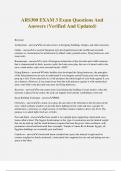ARS300 EXAM 3 Exam Questions And Answers (Verified And Updated) Keystone Architecture - answer✔✔the art and science of designing buildings, bridges, and other structures Gothic - answer✔✔A western Euro pean style developed between the twelfth and sixteenth centuries ce, characterized in architecture by ribbed vaults, pointed arches, flying buttresses, and steep roofs. Romanesque - answer✔✔A style of European architecture of the eleventh and twelfth centu ries that is characterized by thick, massive walls, the Latin cross plan, the use of a barrel vault in the nave, round arches, and a twin -towered facade. ADD? Flying Buttress - answer✔✔Gothic builders also developed the flying buttresses; the principles of the flying buttresses are easy to understand if you imagine yourself using your own weight to prop up a wall. If you stand next to a wall and press the entire length of your body against it, you are a buttress. However, if you stand away from the wall and press against it with outstretched arms, your body is the pier and your arms are flying buttresses. Keystone - answer✔✔the top center stone (used during the building of stone arches); when the keystone is placed in the center, the arch can support itself and the scaffolding is removed. Incan Building Technique - answer✔✔HERE Clerestory - answer✔✔In a Latin cross plan, the area above the triforium in the elevation of the nave, which contains windows to provide direct lighting for the vault and nave. (google : In architecture, a clerestory is a high section of wall that contains windows above eye level. The purpose is to admit light, fresh air, or both.) Post-and-lintel - answer✔✔the basic model is two upright posts supporting a horizontal cross beam called a lintel. The biggest disadvantage to this type of construction are the limited weight that can be held up, and the small distances required between the posts; often rectilinear, with prominent vertical and horizontal lines (example: Temple of Amen -Re in Kar nak, Egypt); all Egyptian buildings are essentially post -and-lintel; Cantilever - answer✔✔a horizontal beam extended into space (the internal weight must be counter weighted or firmly anchored); a horizontal form supported at one end and jutting out into space at the other. Voussoir - answer✔✔wedge -shaped stones (used when making stone arches) Geodesic Dome - answer✔✔A geodesic dome is a skeletal frame based on triangles that are grouped into very stable, strong polyhedrons, which are solid geometric figure s having many sides; (Example: Pantheon); Romans perfected arches as well as domes; it can be very large and require no interior supports; In theory, a structurally sound geodesic dome could be two miles across in diameter; can be easily assembled from pre fabricated modular parts; the framework can be enclosed in glass, plastic, plywood, or a variety of other materials. (example of geodesic dome: Buckminster Fuller's Pavillon) Ceramics - answer✔✔Ceramics, or pottery, is the art or process of making objects out of baked clay. It is one of the oldest crafts and probably grew out of the need to store and carry food and liquids. Ceramic ware is a universal craft found in almost every culture, from ancient times to today. Ceramics are classified according to the type of clay they are made out of and the temperature at which they are fixed. Coiling - answer✔✔A pottery technique in which lengths of rolled clay are wound in a spiral fashion. Kiln - answer✔✔An oven used for drying and firing ceramics. Slip - answer✔✔In ceramics, clay that is thinned to the consistency of cream for use in casting, decorating, or cementing. Potter's Wheel - answer✔✔a horizontal revolving disk on which wet clay is shaped into pots or other round ceramic objects. Terra -cotta - answer✔✔A hard, reddish brown earthenware used in sculpture and pottery; usually left unglazed. Modeling - answer✔✔sculptures may be created by pulling and pushing a malleable substance, such as clay, wax, or plaster, either by hand or with a variety o f tools; it is considered an additive process, because material is built up to create three dimensional forms (most cast statues begin with modeling). Porcelain - answer✔✔A hard, white, translucent, nonporous clay body. The bisque is fired at a relatively low temperature and the glaze at a high temperature; made of fine, white, kaolin clay; fired at 2,400 to 2,500 degrees Fahrenheit. Bisque - answer✔✔a bisque firing is the first firing and removes all water from the clay. add? Industrial - answer✔✔it was th e rapidly increasing demand for consumer goods that gave rise to the art of industrial design. An industrial designer creates for the manufacturer's product a style that will increase its usefulness and efficiency, and more importantly, increase its appeal to the consumer. (examples: machine -made vehicles, appliances, communications equipment, furniture, tools, etc. that we constantly use.)




